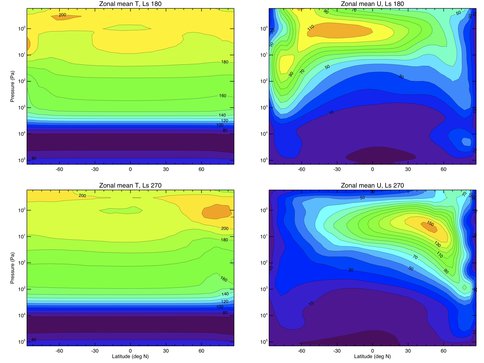2009 Annual Science Report
 NASA Jet Propulsion Laboratory - Titan
Reporting | JUL 2008 – AUG 2009
NASA Jet Propulsion Laboratory - Titan
Reporting | JUL 2008 – AUG 2009
Task 2.1.2 Atmospheric State and Dynamics
Project Summary
An understanding of the structure of the Titan atmosphere provides the context for the formation of complex organic compounds in the atmosphere.
Project Progress
Co-Investigators Mark Richardson and Claire Newman have improved the realism in the TitanWRF simulation of the Titan stratosphere. The Ls=270 (southern summer solstice) model results shown in Figure 1 compare well with recent Cassini temperature observations. They also are making use of the Laboratoire Meteorologie Dynamique (LMD) 2D Titan GCM (output from which is available online at http://web.lmd.jussieu.fr/titanDbase) to develop a reference atmospheric model. Results from this latter model are shown in Figure 2.
Figure 2. Same variables as Figure 1 but now from the LMD Titan climate database.
Figure 1. Temperature, T, and zonal wind, u, as a function of pressure and latitude from TitanWRF for two seasons: northern fall equinox and winter solstice. In each case the data were obtained by averaging TitanWRF output over all longitudes and over 5 degrees of Ls (planetocentric solar longitude, where Ls=270 corresponds to northern winter solstice).
-
PROJECT INVESTIGATORS:
-
RELATED OBJECTIVES:
Objective 1.1
Formation and evolution of habitable planets.
Objective 2.2
Outer Solar System exploration
Objective 3.1
Sources of prebiotic materials and catalysts
Objective 3.2
Origins and evolution of functional biomolecules
Objective 3.3
Origins of energy transduction


